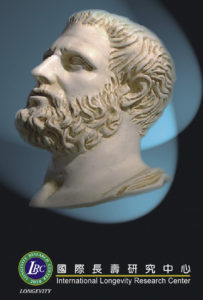
海佛烈克極限(Hayflick limit)指因為端粒(telomere)有分裂次數極限而使細胞停止分裂。於1965年由李奧納多·海佛烈克(Leonard Hayflick)提出,他證明一般人類細胞在細胞培養下,在進入衰老期前可分裂52次,恰好推翻艾力克西斯·卡洛(Alexis Carrel)先前主張的細胞永生說。端粒DNA會隨每次細胞分裂(mitosis)而變短,並縮短細胞「生命時鐘」壽命。
The Hayflick limit refers to the phenomenon where cells stop dividing due to the finite number of times their telomeres can shorten. It was proposed in 1965 by Leonard Hayflick, who demonstrated that normal human cells in culture can divide 52 times before entering senescence. This discovery overturned the previous theory of cellular immortality proposed by Alexis Carrel.
Telomere DNA shortens with each round of mitosis, thereby reducing the “biological clock” lifespan of the cell. It is generally believed that this mechanism primarily functions as a safeguard against the development of cancerous cells. As telomeres shorten with every DNA replication, chromosomal instability increases, leading to cellular apoptosis.
一般相信這個機制主要是防止體內細胞發展為癌細胞。因為隨著每次 DNA 複製 端粒DNA會逐漸變短,進而產生染色體組成不穩定,使細胞進入凋亡期。然而許多幹細胞(stem cell),因為他們尚未分化,所以不被海佛烈克極限影響。幹細胞存於許多身體組織內,某些會在一生中不斷新生,但某些不會(比如腦細胞與某些神經細胞)。
However, stem cells are largely unaffected by the Hayflick limit because they remain undifferentiated. Stem cells exist in many body tissues, with some continuously regenerating throughout life, while others, such as brain cells and certain nerve cells, do not.

細胞利用端粒酶 (Telomerase)合成端粒,或使用其他端粒延長機制以避免端粒變短。 這些機制常在分裂失常的癌細胞中被發現。正常細胞的端粒酶 會隨細胞壽命減少轉錄RNA長度,因此細胞可「正常死亡」,如細胞凋亡(apoptosis),然而癌細胞則否。
Cells use telomerase to synthesize telomeres or employ other telomere extension mechanisms to prevent telomere shortening. These mechanisms are often found in abnormally dividing cancer cells. In normal cells, telomerase activity decreases over time, reducing the length of transcribed RNA, allowing the cell to undergo natural death, such as apoptosis. However, cancer cells do not follow this process.
所有動物細胞皆有其自身的海佛烈克極限,影響其生物壽命長短。細胞代數學說(亦稱細胞分裂次數學說)認為,人體細胞相當於每2.5年更新一代。 經實驗發現,人體細胞在培養條件下平均可培養60代,每一代相當於2.5年,稱為弗列克係數。 據此,人的平均壽命應為2.5 × 60=150歲。
All animal cells have their own Hayflick limit, which influences their lifespan. The cellular generation theory (also known as the cell division limit theory) suggests that human cells renew approximately every 2.5 years. Experiments have shown that human cells, under culture conditions, can divide an average of 60 times, with each generation equivalent to 2.5 years. This is referred to as the Fleck coefficient. Based on this calculation, the theoretical human lifespan would be 2.5 × 60 = 150 years.

世上每一個人的人生,來到地球只有這一趟。雖然,生老病死是自然界的法則,悲歡離合是人類不可避免的必然,但是,如何讓自己的人生過的健康、絢麗、璀璨卻是掌握在自己的。活得健康、活的亮麗才是一個有意義的人生。讓自己有健康、有活力、有魅力是每一個人的基本責任。這樣,才談得上尊重自己,擁抱美好生命。
Every person only has one journey on this Earth. Although birth, aging, illness, and death are natural laws, and joy and sorrow, partings and reunions are inevitable parts of human life, how one lives a healthy, vibrant, and radiant life is entirely within one’s own control. Living with health and brilliance is what gives life true meaning. It is everyone’s basic responsibility to ensure they are healthy, energetic, and charismatic. Only then can we say we truly respect ourselves and embrace the beauty of life.
獲得健康,延長人類壽命,是自古以來人類所共同追求的美夢。然而,身為一個現代人,如何展現生命的意義,是當今我們所面對的一項重要課題。身心健康才是真正的健康,隨時接受新的資訊,淨化為有用的知識,身體力行,做好個人的健康管理,為自己的身心加上一層保護膜,如此,才能減少外來因素對人類健康的傷害,做一個健康的現代人。在此,本中心,真誠祝福每個人都能夠如願。
Achieving good health and extending human life has been a shared dream of mankind since ancient times. However, as modern individuals, how we express the meaning of life is an important issue we must face today. True health is both physical and mental. By constantly receiving new information, transforming it into useful knowledge, and putting it into practice to manage our own well-being, we can create a protective shield for our body and mind. In this way, we reduce external harm to our health and become healthy modern individuals.
Here, our center sincerely wishes that everyone may achieve this aspiration.
